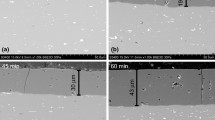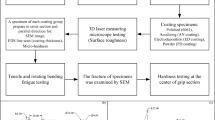Abstract
The wear resistance of hard anodic coatings fabricated on 5005 and 6061 aluminum alloys was determined. The Taber abrasion test, ball-on-disc tribological test, and scratch test at constant load were conducted. The wear resistance of the hard coating fabricated on the 6061 alloy was found to be higher compared to the coating on the 5005 alloy. This is related to the lower nanoscale porosity of the former, and the higher hardness of the 6061 alloy compared to 5005. The specific wear rates for the load of 4.905 N were equal to 1.70 × 10−5 and 1.02 × 10−5 mm3 N−1 m−1 for the coatings on 5005 alloy and 6061 alloy, respectively. In the case of the hard anodized 5005 alloy, the specific wear rate increased with increasing load to 4.56 × 10−5 mm3 N−1 m−1 whereas for anodized 6061 alloy to 1.98 × 10−5 mm3 N−1 m−1. It was also found that the protective properties of the coating on 6061 alloy do not change significantly across the coating thickness.












Similar content being viewed by others
Data availability
The data that support the findings of this study are available from the corresponding author upon reasonable request.
References
Starke EA, Staley JT. Application of modern aluminium alloys to aircraft. Prog Aerosp Sci. 2010;32:131–72. https://doi.org/10.1533/9780857090256.3.747.
Miller WS, Zhuang L, Bottema J, Wittebrood AJ, De Smet P, Haszler A, Vieregge A. Recent development in aluminium alloys for the automotive industry. Mater Sci Eng A. 2000;280:37–49. https://doi.org/10.1016/S0921-5093(99)00653-X.
Suzuki Y. Surface modifications of pistons and cylinder liners. J Mater Eng. 1988;10:61–7. https://doi.org/10.1007/BF02834115.
Sheasby PG, Pinner R, Wernick S. The surface treatment and finishing of aluminium and its alloys. Trowbridge: ASM International; 2001.
Martínez-Viademonte MP, Abrahami ST, Hack T, Burchardt M, Terryn H. A review on anodizing of aerospace aluminum alloys for corrosion protection. Coatings. 2020;10:1–30. https://doi.org/10.3390/coatings10111106.
Korzekwa J. Modification of the structure and properties of oxide layers on aluminium alloys: a review. Rev Adv Mater Sci. 2023;62:1–26. https://doi.org/10.1515/rams-2023-0108.
Gabe DR. Hard anodizing-what do we mean by hard ? Met Finish. 2002;100:52–8.
Runge JM. The metallurgy of anodizing aluminum. Cham: Springer; 2018.
Kwolek P, Drapała D, Krupa K, Obłój A, Tokarski T, Sieniawski J. Mechanical properties of a pulsed anodised 5005 aluminium alloy. Surf Coat Technol. 2020. https://doi.org/10.1016/j.surfcoat.2019.125233.
Wheeler JM, Curran JA, Shrestha S. Microstructure and multi-scale mechanical behavior of hard anodized and plasma electrolytic oxidation (PEO) coatings on aluminum alloy 5052. Surf Coatings Technol. 2012;207:480–8. https://doi.org/10.1016/j.surfcoat.2012.07.056.
Guezmil M, Bensalah W, Khalladi A, Elleuch K, De-Petris Wery M, Ayedi HF. Effect of test parameters on the friction behaviour of anodized aluminium alloy. Int Sch Res Not. 2014;2014:1–9. https://doi.org/10.1155/2014/795745.
Kwolek P, Krupa K, Obłój A, Kocurek P, Wierzbińska M, Sieniawski J. Tribological properties of the oxide coatings produced onto 6061-T6 aluminum alloy in the hard anodizing process. J Mater Eng Perform. 2018;27:3268–75. https://doi.org/10.1007/s11665-018-3421-8.
Krishna LR, Purnima AS, Sundararajan G. A comparative study of tribological behavior of microarc oxidation and hard-anodized coatings. Wear. 2006;261:1095–101. https://doi.org/10.1016/j.wear.2006.02.002.
Sola R, Tonelli L, Shashkov P, Bogdanoff TH, Martini C. Anodizing of AA6082-T5 by conventional and innovative treatments: microstructural characterization and dry sliding behaviour. Wear. 2020;458–459:203423. https://doi.org/10.1016/j.wear.2020.203423.
Mohitfar SH, Mahdavi S, Etminanfar M, Khalil-Allafi J. Characteristics and tribological behavior of the hard anodized 6061-T6 Al alloy. J Alloys Compd. 2020;842:1–12. https://doi.org/10.1016/j.jallcom.2020.155988.
Soffritti C, Fortini A, Nastruzzi A, Sola R, Merlin M, Garagnani GL. Dry sliding behavior of an aluminum alloy after innovative hard anodizing treatments. Materials. 2021;14:1–19. https://doi.org/10.3390/ma14123281.
Malayoglu U, Tekin KC, Malayoglu U, Shrestha S. An investigation into the mechanical and tribological properties of plasma electrolytic oxidation and hard-anodized coatings on 6082 aluminum alloy. Mater Sci Eng A. 2011;528:7451–60. https://doi.org/10.1016/j.msea.2011.06.032.
Sieber M, Scharf I, Herold F, Schmidt A, Böttger D, Böttger S, Böttger E, Götze U, Lampke T. Anodic oxidation of AlMgSi1—coatings’ mechanical properties, process costs and energy consumption of the oxide formation. Mater Des. 2016;89:1259–69. https://doi.org/10.1016/j.matdes.2015.10.064.
Huang H, Qiu J, Wei X, Sakai E, Jiang G, Wu H, Komiyama T. Ultra-fast fabrication of porous alumina film with excellent wear and corrosion resistance via hard anodizing in etidronic acid. Surf Coatings Technol. 2020;393:125767. https://doi.org/10.1016/j.surfcoat.2020.125767.
Santecchia E, Cabibbo M, Hamouda AMS, Musharavati F, Popelka A, Spigarelli S. Dry sliding tribological properties of a hard anodized AA6082 aluminum alloy. Metals (Basel). 2020;10:207–22.
ASTM B137-95 (2014). Standard test method for measurement of coating mass per unit area on anodically coated Aluminum; 2009.
Nowak WJ. Characterization of oxidized Ni-based superalloys by GD-OES. J Anal At Spectrom. 2017;32:1730–8. https://doi.org/10.1039/C7JA00069C.
Gaiaschi S, Richard S, Chapon P, Acher O. Real-time depth measurement in glow discharge optical emission spectrometry: via differential interferometric profiling. J Anal At Spectrom. 2017;32:1–7. https://doi.org/10.1039/c7ja00146k.
ASTM D4060-09. Standard test method for abrasion resistance of organic coatings by the Taber Abraser; 2009.
ASTM G99-95a. Standard test method for wear testing with a pin-on-disk apparatus; 2000.
Oliver WC, Pharr GM. An improved technique for determining hardness and elastic modulus using load and displacement sensing indentation experiments. J Mater Rese. 1992;7:1564–83.
Mondolfo LF. Aluminum alloys: structure and properties. London: Butterworths & Co.; 1976.
Zhang F, Nilsson J-O, Pan J. In situ and operando AFM and EIS studies of anodization of Al 6060: influence of intermetallic particles. J Electrochem Soc. 2016;163:C609–18. https://doi.org/10.1149/2.0061610jes.
Fratila-Apachitei LE, Terryn H, Skeldon P, Thompson GE, Duszczyk J, Katgerman L. Influence of substrate microstructure on the growth of anodic oxide layers. Electrochim Acta. 2004;49:1127–40. https://doi.org/10.1016/j.electacta.2003.10.024.
Zhu B, Zanella C. Influence of Fe-rich intermetallics and their segregation on anodising properties of Al–Si–Mg rheocast alloys. Surf Coat Technol. 2021;422:127570. https://doi.org/10.1016/j.surfcoat.2021.127570.
Jariyaboon M, Møller P, Dunin-Borkowski RE, Ambat R. FIB-SEM investigation of trapped intermetallic particles in anodic oxide films on AA1050 aluminium. Anti Corros Methods Mater. 2011;58:173–8. https://doi.org/10.1108/00035591111148885.
Edwards GA, Stiller K, Dunlop GL, Couper MJ. The precipitation sequence in Al–Mg–Si alloys. Acta Mater. 1998;46:3893–904. https://doi.org/10.1016/S1359-6454(98)00059-7.
Mrówka-Nowotnik G, Sieniawski J. Influence of heat treatment on the microstructure and mechanical properties of 6005 and 6082 aluminium alloys. J Mater Process Technol. 2005;162–163:367–72. https://doi.org/10.1016/j.jmatprotec.2005.02.115.
van Put MA, Abrahami ST, Elisseeva O, de Kok JMM, Mol JMC, Terryn H. Potentiodynamic anodizing of aluminum alloys in Cr VI-free electrolytes. Surf Interface Anal. 2016;48:946–52.
Aerts T, Dimogerontakis T, De GI, Fransaer J, Terryn H. Influence of the anodizing temperature on the porosity and the mechanical properties of the porous anodic oxide film. Surf Coat Technol. 2007;201:7310–7. https://doi.org/10.1016/j.surfcoat.2007.01.044.
MIL-A-8625F. Anodic coatings for aluminum and aluminum alloys; 1993.
Bull SJ. Failure modes in scratch adhesion testing. Surf Coat Technol. 1991;50:25–32. https://doi.org/10.1016/0257-8972(91)90188-3.
Williams JA. Analytical models of scratch hardness. Tribol Int. 1996;29:675–94. https://doi.org/10.1016/0301-679X(96)00014-X.
Acknowledgements
The authors gratefully acknowledge Grażyna Mrówka-Nowotnik, D.Sc., for her valuable comments.
Author information
Authors and Affiliations
Corresponding author
Ethics declarations
Conflict of interest
The authors declare that they have no conflict of interest.
Ethical approval
Authors state that the research was conducted according to ethical standards.
Additional information
Publisher's Note
Springer Nature remains neutral with regard to jurisdictional claims in published maps and institutional affiliations.
Supplementary Information
Below is the link to the electronic supplementary material.
Rights and permissions
Springer Nature or its licensor (e.g. a society or other partner) holds exclusive rights to this article under a publishing agreement with the author(s) or other rightsholder(s); author self-archiving of the accepted manuscript version of this article is solely governed by the terms of such publishing agreement and applicable law.
About this article
Cite this article
Kwolek, P., Obłój, A., Kościelniak, B. et al. Wear resistance of hard anodic coatings fabricated on 5005 and 6061 aluminum alloys. Archiv.Civ.Mech.Eng 24, 51 (2024). https://doi.org/10.1007/s43452-024-00866-0
Received:
Revised:
Accepted:
Published:
DOI: https://doi.org/10.1007/s43452-024-00866-0




